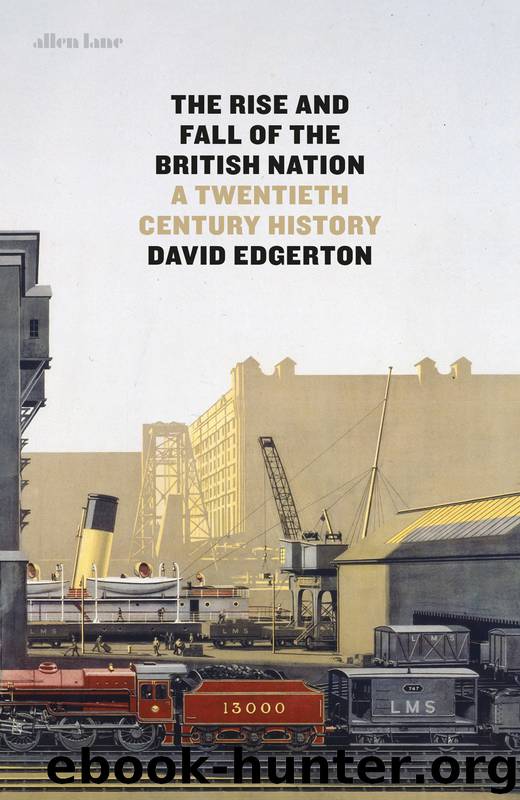The Rise and Fall of the British Nation by David Edgerton

Author:David Edgerton
Language: eng
Format: epub
ISBN: 9780141975962
Publisher: Penguin Books Ltd
Published: 2018-05-25T16:00:00+00:00
CARS AND SHIPS
Textiles were clearly a dying industry, but there were many industries which were extraordinarily successful. The British motor car industry was very large and fast-growing, and rapidly changing. In 1950 it was not only the largest car producer in Europe but the largest exporter of cars in the world. It accounted for 17 per cent of British exports in the early 1960s, and one-quarter of world exports of cars. Into the early 1970s the industry remained a very significant exporter – around 40 per cent of its output went overseas. The British Motor Corporation, a merger of the giant Austin and Morris firms, was the largest car maker in Europe in the late 1960s and the United Kingdom’s largest single exporter.29 It exported over a third of its production. It went multinational and bought factories in Italy and Belgium. Imports were minimal, though edging higher, already over one in ten new British cars by 1970. It was, however, the British car industry which brought cars, easily the most expensive family purchase other than a house, to the British masses by the 1970s.
The car industry had modern equipment. Many of the wartime aero-engines and aircraft factories in the West Midlands were turned over to cars. Vast new plants were added with government support in the early 1960s, taking the industry away from its centre around London and the West Midlands. The US-owned firms were in the lead. Ford built a new factory in Halewood (it made Anglias, later Escorts) while General Motors went to Ellesmere Port (making Vivas). Both factories soon grew to over 10,000 employees each. Rootes (soon to be taken over by Chrysler) went to Linwood in Scotland.30 The industry succeeded in expanding production into the early 1970s, not least through these new plants.
British car production peaked in 1972 and went into a rapid absolute decline. The change came with the opening of markets to foreign cars. Not only did the general British tariff fall but it was abolished within the Common Market, such that by the late 1970s, European cars came in for nothing. Japanese cars paid 11 per cent. In the 1970s British Leyland, which succeeded BMC, saw its production halved. It was nationalized and closed many factories. By 1981 it was a small producer, concentrated in Longbridge and Cowley, and was smaller even than LADA of the USSR, not to mention FIAT, Renault, Citroën and Peugeot, or Volkswagen. The British nation now produced more cars than Spain or Canada, though not by much.31 It was telling that the two long-established American firms in the United Kingdom, Ford and General Motors (Vauxhall), both did relatively well, and did so by integrating their production across Europe. The Ford Escort (1967–) was built in Halewood and in Germany and had been designed as a European car; the Vauxhall Viva was a variant of the Opel Kadett. Opel was the German arm of General Motors, Vauxhall the British.
The case of shipbuilding is another one of early success followed by a failure even in the domestic market.
Download
This site does not store any files on its server. We only index and link to content provided by other sites. Please contact the content providers to delete copyright contents if any and email us, we'll remove relevant links or contents immediately.
International Integration of the Brazilian Economy by Elias C. Grivoyannis(90803)
The Radium Girls by Kate Moore(11921)
Turbulence by E. J. Noyes(7935)
Nudge - Improving Decisions about Health, Wealth, and Happiness by Thaler Sunstein(7615)
The Black Swan by Nassim Nicholas Taleb(7010)
Rich Dad Poor Dad by Robert T. Kiyosaki(6399)
Pioneering Portfolio Management by David F. Swensen(6226)
Man-made Catastrophes and Risk Information Concealment by Dmitry Chernov & Didier Sornette(5921)
Zero to One by Peter Thiel(5685)
Secrecy World by Jake Bernstein(4643)
Millionaire: The Philanderer, Gambler, and Duelist Who Invented Modern Finance by Janet Gleeson(4374)
The Age of Surveillance Capitalism by Shoshana Zuboff(4209)
Skin in the Game by Nassim Nicholas Taleb(4161)
Bullshit Jobs by David Graeber(4094)
The Money Culture by Michael Lewis(4076)
Skin in the Game: Hidden Asymmetries in Daily Life by Nassim Nicholas Taleb(3929)
The Dhandho Investor by Mohnish Pabrai(3698)
The Wisdom of Finance by Mihir Desai(3650)
Blockchain Basics by Daniel Drescher(3506)
